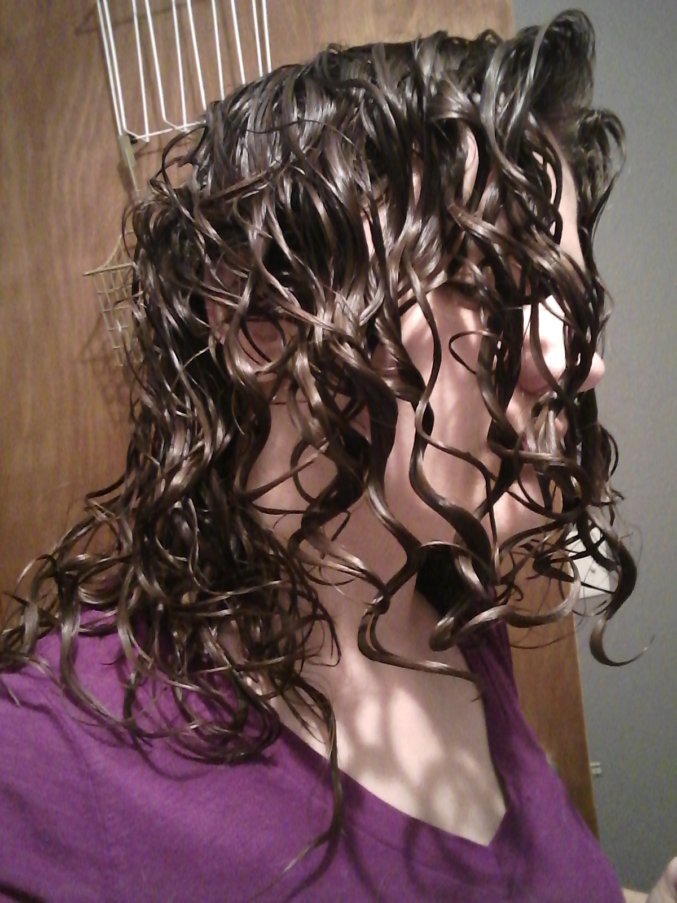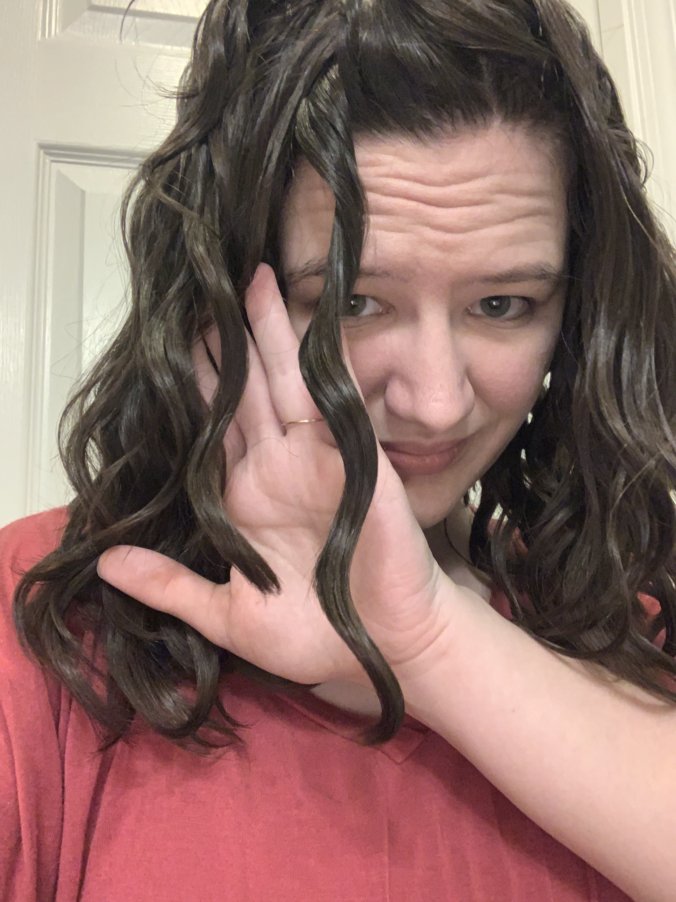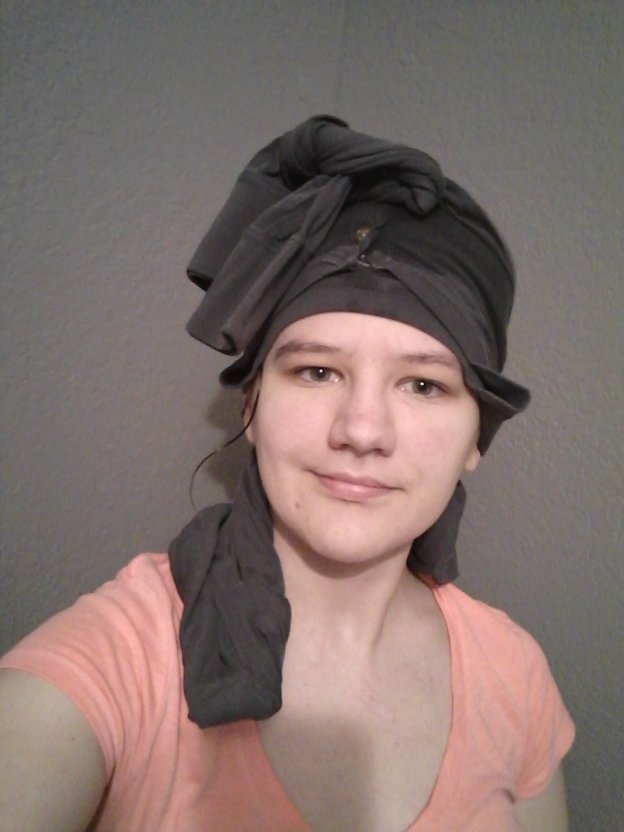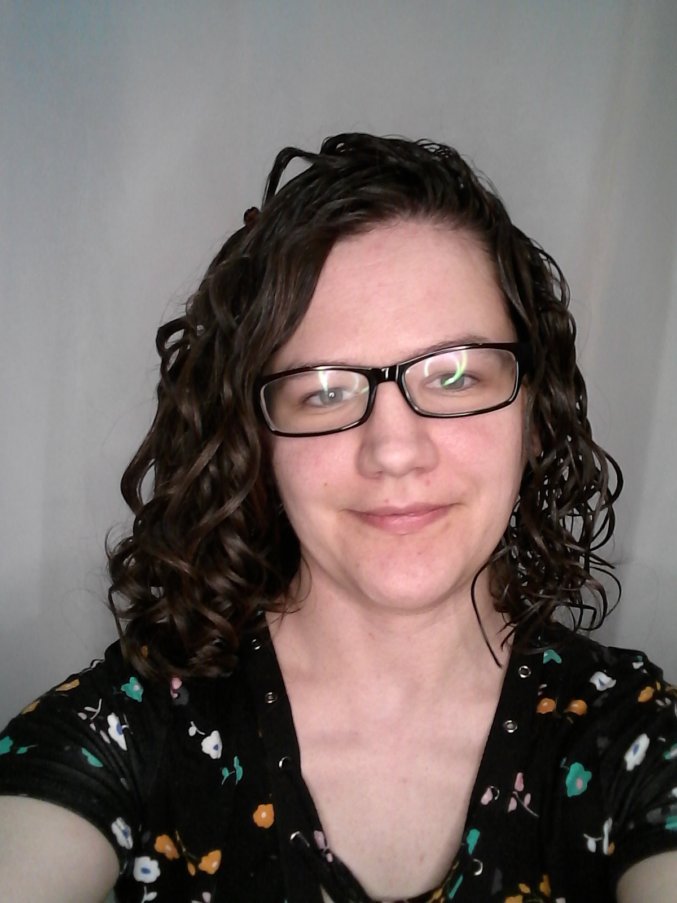When you’re new to finding the curly girl method or wavy curly hair communities, you’re likely to come across some terms, abbreviations and acronyms that are pretty confusing. Wavy and curly communities have made up some of our own words and have a bit of “insider” lingo that we are familiar with, but outsiders and newbies aren’t.
I find that sometimes I forget that not everyone knows what these terms, abbreviations and acronyms mean. I’ve been using them for so long now that I forget they aren’t “normal” words. I thought I’d put together a list of terms, abbreviations and acronyms that are unique to the curly girl method and/or wavy curly communities to help newbies gain a deeper understanding of our lingo.

Curly Girl Method Terms & Lingo
2a, 2b, 2c, 3a, etc. These refer to where someone’s hair falls on a curl pattern chart. Straight hair is “type 1”, Wavy is “type 2”, Curly is “type 3” and coily or kinky is “Type 4”. a, b, and c are ranges within those three categories, so 2a is loose waves and 2c is tight waves. Visit my post wavy hair curl pattern chart to learn more and see examples.
90% dry (or other percentages). We use percentages to explain how close to ‘fully dry (aka 100% dry)’ our hair is. I didn’t realize this was part of our lingo until I used it with my boyfriend. He laughed and asked why I didn’t just say that my hair is ‘almost dry’ instead. I realized that I had learned to use percentages because that’s what I saw other wavies and curlies doing in different groups! I don’t really know why we don’t say something like ‘mostly dry’ or ‘super close to dry’ instead of using percentages but…it’s just the norm to use percentages!
Buff. Buffs are similar to hair bonnets, but instead of being a closed cap they’re more like a long sleeve. This means if you have longer hair, you can have the ends of your hair stick out of the buff rather than have them folded into a cap. Some just find them more comfortable than bonnets.
Canopy. The canopy of your hair is basically the exterior layer of your hair. The part of your hair that you can touch using a flat hand, or that sun can reflect off of.

My hair is totally dry in this picture, it just looks wet (and stiff) because it is in a hair cast.
Cast. A hair cast is when you use a product like gel or mousse and it leaves a crunchy feeling on your hair.
Clarify. When we clarify our hair we’re talking about using a stronger shampoo (usually one with sulfates) to get rid of any product build up or any other kind of buildup on our hair.

In this photo I’m showing two curl clumps in front of my hand.
Clumps. Clumps (aka curl clumps) are what you might think of as individual curls. With heat-styled hair, it’s common to take a section of dozens or hundreds of hair, wrap it around a curling iron and then say that it made one “curl” because all of those hairs would take the same shape and stay together as a group. With naturally wavy or curly hair, we don’t use a curling iron but we still have groups of dozens or hundreds of hairs that together made what looks like one ‘curl’. So to put it another way, each ‘curl’ is a curl clump. We also talk about ‘clumps’ regarding curl size or thickness. The same way that some people who use a curling iron like to use a lot of hair to make one big curl, some people with naturally wavy or curly hair like to try to get their hair to make bigger clumps. I have a blog post titled How To Get Bigger Curl Clumps if you’d like some tips for this.
Co-wash. Co-wash is short for conditioner-wash. Some people wash their hair using products that are marketed as conditioners, and this is called cowashing. Some companies make products that are specifically marketed as co-washes, and these are very light cleansers designed to mimic the effect of washing your hair with conditioner, but with a little help from a mild cleanser.
Day 2 hair. (or day 3 hair, etc). Most people who are following the curly girl method or who are otherwise embracing their natural waves or curls don’t wash their hair every day. Day 2 hair would be your hair the day after wash day. So if you washed your hair on a Monday, then Tuesday you’d have “day 2 hair”, Wednesday you’d have “day 3 hair” etc until you washed your hair again. Many people refresh their hair on non-wash days, but that doesn’t reset the count. So if you washed your hair Monday and refreshed on Tuesday, your Wednesday hair would still be considered day 3 hair.
Density. Of course, density is a ‘normal’ word too, but people are sometimes confused by what it means within hair communities. In terms of hair it refers to how many hairs you have on your head. Some people have more hairs per square inch of scalp than others. If someone has sparse hairs we call this low density, if someone has a lot of hairs this is called high density. When people are in-between this is called average density or medium density. If you’d like to figure out if your hair is low, average or high density check out my post how to determine your wavy hair type.
Dry plopping. Dry plopping is when people plop their hair (scroll down to the P section if you’re unfamiliar with plopping of any type) but dry plopping is done after their hair has already dried. Some people do this to protect their hair while hanging out around their house, or while sleeping.
Finger curling. Finger curling is a technique that is used to twist hair around your finger to help it curl. Some people will finger curl their entire head on wash day so that it dries with a uniform curl clump size. Others will finger curl specific sections of their hair that are straighter than the rest.
Finger rolling is a technique that is somewhat similar to finger curling, but it’s done by rolling two fingers inside of a section of hair, while finger curling is done by twisting a section of hair around your fingers.

Hover diffuse is a technique for diffusing. It’s done by hovering your diffuser around your head rather than putting your hair inside of your diffuser. I have a blog post comparing 4 styles of hair diffusing that explains how to hover diffuse.
Low poo is a term used to describe curly girl method-approved shampoos, meaning sulfate-free shampoos. These are believed to be gentler shampoos, and they’re what a lot of people with wavy hair use on ‘regular’ wash day.

Microplop. Microplopping is a technique for helping wavy or curly hair start to dry, or to remove excess water from hair after washing. It can also be used to scrunch hair after a shower to help curls gain definition or tightness. I have a blog post on how to microplop your hair if you’d like to learn more or see a visual tutorial.
No poo is when someone doesn’t use shampoo at all. Instead they rely on physical cleaning (massaging the scalp) and other very natural methods.
Pigtail cut is a type of do-it-yourself haircut that was popularized by Manes By Mel. It’s similar to a unicorn cut, but it involves putting your hair into pigails before cutting. You can see the pigtail cut video by clicking that link.
Pineapple. Not the fruit, of course! In the wavy curly world, to pineapple your hair means to secure your hair on top of your head with a loose bun. This is usually done overnight, as a way of protecting your waves while you sleep. Some may use it during the day, too though. Check out my post how to sleep on wavy hair to read more about pineappling.
Pixie diffusing is a method of diffusing. It involves loading your hair into the diffuser from below, and pressing the diffuser against your scalp. You can see my tutorial with pictures for how to pixie diffuse in my diffusing blog post.

Plop. What a silly term! Plopping is the term used to describe the common practice of using a t-shirt or microfiber towel to wrap wavy or curly hair against your head. Most often this is done after washing to keep the hair from getting stretched out by water as it dries. Some people dry plop as a protective measure, though. Check out my post how to plop wavy hair to see my step by step tutorial with photos.
Praying hands. Praying hands is a technique for applying products to the hair. It involves spreading hair product between your hands and then running your hands over the inside ad outside of your hair in the ‘praying hands’ position to help distribute products across your strands. Soon I’ll be doing a blog post showing product application techniques, as it’s easier to show than to describe.
Pre-poo. Pre-poos are hair treatments (usually oils) that are done before washing (aka pre-shampooing). These are done before shampooing to help protect the hair from getting dehydrated when it is shampooed. They can assist with helping hair get better moisturized, and they can make it easier to detangle your hair.
Pulsing. Pulsing is when hands are held in the same position, but squeezed and released over and over. This helps squish water and/or hair products into the hair, and may be particularly beneficial for low porosity hair. This is often done along with squish to condish.
Raking. Raking is a product application technique. It’s using your fingers like a “rake” to work product throughout your hair. I’ll be doing a blog post showing tutorials for, and comparing different application techniques soon.
Ramen noodle hair. Another goofy one! If you’ve ever seen a block of instant ramen noodles, that’s where this term comes from. Some people feel that if their hair is too crunchy or defined, or lacking bounce, that it looks like a block of ramen noodles. So, if you ever see someone say ‘ugh, I have ramen noodle hair today’ they mean their hair is lacking bounce or a soft look.
Refresh. Refreshing is when people do things to try to improve the appearance of their hair between wash days. For some this is as simple as shaking their hair in the morning, or spritzing it with water. For others it can be a multi-step routine. I have a blog post called the best way to refresh wavy hair 8 techniques compared if you want to learn more about refreshing in different ways.
Roping. Roping is a product application technique. It’s when you separate your hair into sections (aka ropes) and then squeeze your hand around the outside of the ‘rope’ of hair. Prior to doing this, you spread your product along your palms and fingers so that when you squeeze your hands around your hair, it applied the product. Blog post showing application techniques coming soon!
Scrunch. Scrunching hair is when you gather some hair in your hand and squeeze. You gather the hair from below the ends and let it pool in your hands in their natural formation, and then squeeze. Scrunching is done for different reasons. Some scrunch their hair after their shower to remove excess water. Some apply hair products to their hands and then scrunch their hair as a method for applying their products to their hair. It’s also common to scrunch hair to break the gel cast after your hair has dried.

In this photo on the left side I’ve scrunched out the crunch, while the hair on the right side of my hair is still in a gel cast.
Scrunch out the crunch. Scrunching ou the crunch is using the scrunch motion described above to break the gel cast. Many gels, mousses and other styling products will create a crunchy “shell” on the exterior of your curl clumps. This can help your hair hold its shape really nicely, but many people dislike how a gel cast can make hair look stiff and wet. Scrunching out the crunch is often done to get rid of that wet look and crunchy look and feel.
Seaweed hair. Seaweed hair is a term used to describe a feeling that hair gets when you use a lot of conditioner in the shower, while also keeping your hair really wet. When aiming to help their hair get really well moisturized, some people keep their hair wet while adding conditioner until they get that “seaweed hair” feeling which tells them they’ve used enough conditioner. It’s a certain type of really slippery, saturated-with-conditioner feeling that people say feels like seaweed.
Shrinkage. Shrinkage is when hair appears to get shorter as it dries. Typically, the tighter your curl pattern is, the more shrinkage you’ll experience.
Smasters. Smasters is a styling technique that involves adding in more hair products after your hair is about halfway dry. The goal with smasters is to get a lot of hold and definition. The technique was created by someone on the NaturallyCurly forums whose username included ‘Smasters’, so the name is giving the credit to the creator.
Stringy. Stringy hair is used to describe hair that is not clumping or is only forming really skinny clumps. It’s common for people to struggle with stringy hair when they are new to embracing their waves. If you want stringy hair help check out my blog post stringy wavy hair.
Thick hair. I know, you think you know what this one means! And maybe you do, but maybe not. In many places of society, ‘thick hair’ is used to describe any hair that looks thick. In wavy and curly hair groups, thick hair means that your individual hair strands are thick, rather than fine. We use hair density to refer to someone who has ‘thick hair’ in the sense that their hair looks really big or full.
Unicorn cut. The unicorn cut is a type of haircut that people with wavy or curly hair do on themselves. It’s called a unicorn cut because it involves putting your hair in a ponytail in the front of your hair (Roughly where a unicorn’s horn would be) and then cutting the hair.
Wash day. Wash day is the day when we wash our hair. Those who are new may ask ‘isn’t every day wash day, then?” and the answer is usually no. Most people with wavy or curly hair don’t wash their hair daily, which is why we refer to the days where we do wash our hair as a ‘wash day’. I have a blog post on how often should you wash wavy hair if you want to learn more.
Wolf cut. This is another do-it-yourself haircut, this one became popular on TikTok. IT’s similar to the unicorn cut but it involves placing the ponytail farther back on the head, which changes where the layers will fall. This creates more of a shag style haircut.
Curly Girl Method Abbreviations & Acronyms
ACV stands for apple cider vinegar. Some people mix apple cider vinegar with water as a way of clarifying their hair.
AIF stands for Aussie Instant Freeze. This is technically a small line of hair care products, but in most cases when people refer to AIF they’re talking about the gel. Aussie Instant Freeze Gel is a favorite for many wavies and curlies. Personally, I don’t love the AIF gel but I do like the AIF mousse!
CGM stands for curly girl method.
DC usually stands for deep conditioner, but some may use it to reference the brand DevaCurl as well.
FSG stands for flax seed gel. It’s common for people to like to make their own hair gel using flax seeds, and some brands make flax seed based hair gels that you can purchase in stores, too.
HG stands for holy grail. When someone says that a product is ther holy grail they basically mean it’s their absolute favorite product in that category, it does everything they want a product of that type to do.
KCCC or KCKT. Kinky Curly is a brand of hair products. They have two products that are exceptionally popular in the groups I’m in. Kinky Curly Curling Custard is often shortened to KCCC, and Kinky Curly Knot Today (a leave in conditioner) is often shortened to KCKT.
NPF stands for Neutral Protein Filler. At some beauty supply stores like SallyBeauty you can purchase neutral protein filler, which is basically pure protein drops. These can be added to other products to make them have a higher protein content.
NYM is short for Not Your Mother’s, a brand of hair products that is popular in wavy and curly groups. The brand has a large line called Not Your Mother’s Naturals and that is often shortened to NYMN.
SM stands for SheaMosture, a brand of hair care products that is popular with people with wavy or curly hair.
SOTC stands for scrunch out the crunch. If you aren’t familiar with what scrunch out the crunch means, scroll up to the above section as I define it up there!
STC is an acronym for squish to condish. I explained what squish to condish is higher up in this post if you’re unfamiliar with what that is.
UFD is short for Uncle Funky’s Daughter. This is a brand of hair products, so UFD could be referencing the brad in general. However, in many cases it’s also used to specifically refer to one particular product, Uncle Funky’s Daughter Curly Magic Curl Stimulator. This product is exceptionally popular in wavy/curly groups and most other products from the brand aren’t talked about much. So UFD is often used to reference that one product although it’s a whole brand.
As a new member, this was SO helpful!